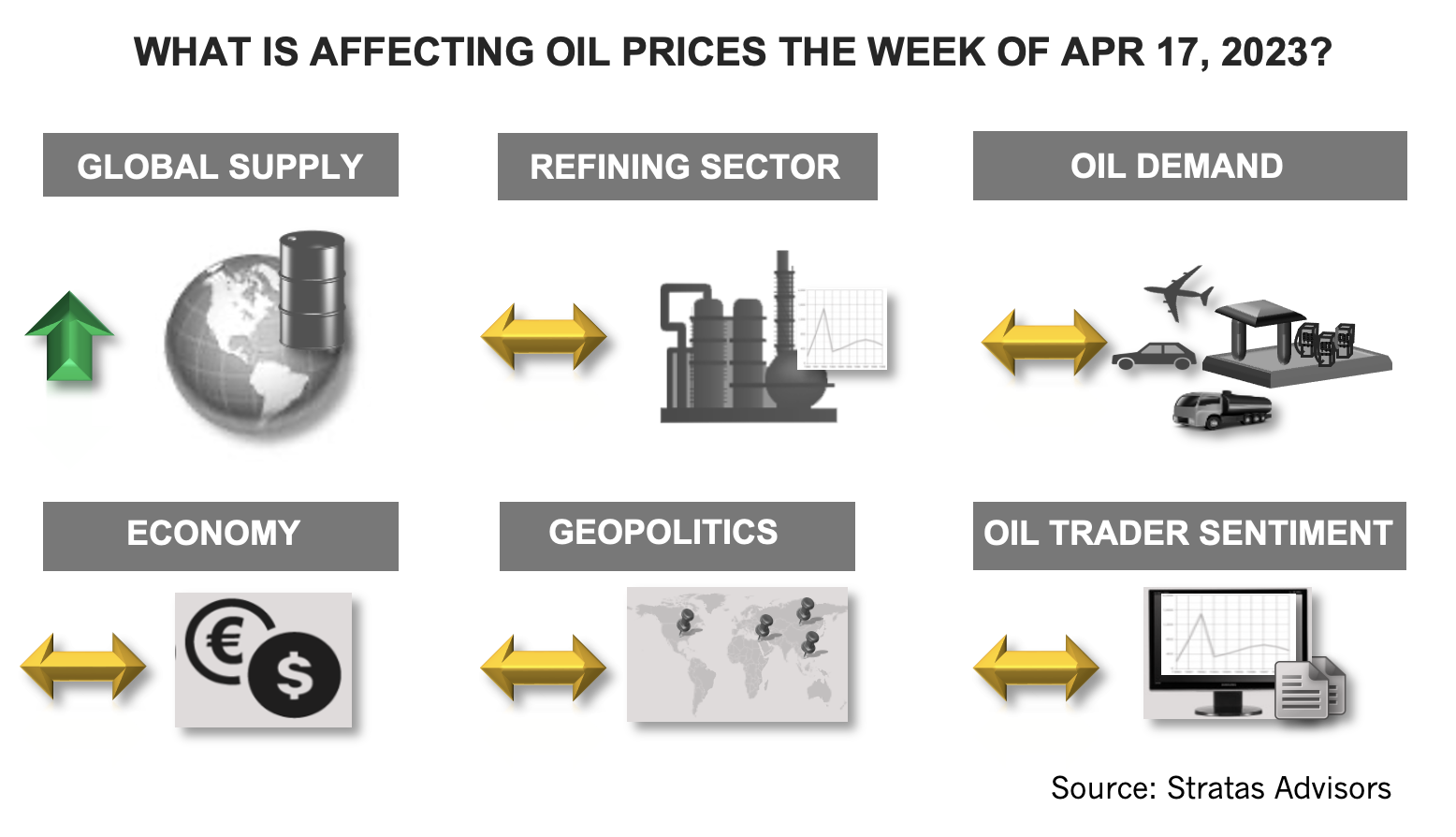
Stratas Advisors is remaining cautiously optimistic about oil prices. (Source: Shutterstock)
The price of Brent crude ended the week at $86.31 after closing the previous week at $85.12. The price of WTI ended the week at $82.52 after closing the previous week at $80.70.

As we expected, the pending production cuts pushed oil prices higher and past resistance levels for Brent ($86.00) and WTI ($82.00). Besides the pending production cuts announced by OPEC+, oil prices are getting some support from the weakness of the U.S. Dollar. Last week, the U.S. Dollar Index ended at 101.55 at from 102.09 of the previous week and is well below the 114.10 that was reached at the end of September 2022.
Prices might have also gotten a little bump from the U.S. Energy Secretary Jennifer Granholm indicating last week that the Biden Administration plans to refill the U.S. Strategic Petroleum Reserve (SPR) yet this year. We remain highly skeptical of this happening, especially since the possibility was raised with the caveat that such purchases will only occur if advantageous for U.S. taxpayers. Additionally, inventories at the SPR are now declining again to meet the budget requirement to sell another 26 million barrels.
As we highlighted last week, for the rest of the year, we are forecasting that the price of Brent crude oil will average $93.13, which compares to our previous forecast of $88.57. We also highlighted that there is more downside risk than upside risk to the forecast.
China had a significant increase in crude imports with March imports 22.5% higher than during March of last year. For the first quarter, China’s crude imports were 6.7% higher than that of the previous year. However, some of the increase in crude imports is stemming from China exporting more refined products. During March, Chinas’ exports increased by 35.1% in comparison to March of last year, which translated to an increase of more than 300,000 bbl/d (around 1.4 million tonnes). Additionally, China’s economy is still growing moderately since the removal of the zero-COVID policies. While the March PMI for services increased to 57.80 from 55.00 in February, the manufacturing PMI decreased from 51.60 to 50.00. Consequently, the composite PMI only increased to 54.50 from 54.20.
RELATED
China’s COVID Pivot Boosts Oil, Gas, LNG Demand
Last week, there were some additional signs of inflation slowing down in the U.S. The consumer price index (CPI) increased last month by 0.1% and by 5% on an annual basis. The increase was the smallest since June 2021 and was driven by the reduction in energy prices and by the first decrease in food prices since September 2020. The cost of shelter continues to be a major source of inflation in that it represents about 33% of the CPI. The cost of shelter increased by 0.6%, and while it was the smallest increase since November, the increase translates into 8.2% on an annual basis.
While the rate of inflation is slowing down, it appears to be happening, in conjunction with increasing stress on the economy:
- Retail sales decreased by 1% in March after sales decreased by 0.2% in February
- Real wages have been falling for 24 consecutive months
- Consumer debt is at record levels with record-level interest rates
Additionally, as we highlighted last week, the U.S. job market is cooling. The jobs report for March indicated that the U.S. economy added 236,000, which is the lowest level of monthly increases since December 2020. Additionally, the number of job openings dropped to 9.93 million, which is the first sub-10 million reading in nearly a decade. The number of layoffs increased to nearly 90,000, which is a 15% increase in comparison to February. Continuing jobless claims reached 1.823 million, which is the highest level since December 2021. Another sign of the U.S. economy slowing down is that according to the Association of American Railroads (AAR) through the first quarter of this year, total North American carload and intermodal traffic is 3.9% less in comparison with last year. Despite the weakness in the U.S. economy, we are expecting that the Federal Reserve will increase interest rates by another 0.25% at its next meeting in early May, in part, because core inflation (stripping our food and energy) continues to be elevated with the monthly increase of 0.4% in March and 5.6% on an annual basis.
For a complete forecast of refined products and prices, please refer to our Short-term Outlook.
About the Author: John E. Paise, president of Stratas Advisors, is responsible for managing the research and consulting business worldwide. Prior to joining Stratas Advisors, Paisie was a partner with PFC Energy, a strategic consultancy based in Washington, D.C., where he led a global practice focused on helping clients (including IOCs, NOC, independent oil companies and governments) to understand the future market environment and competitive landscape, set an appropriate strategic direction and implement strategic initiatives. He worked more than eight years with IBM Consulting (formerly PriceWaterhouseCoopers, PwC Consulting) as an associate partner in the strategic change practice focused on the energy sector while residing in Houston, Singapore, Beijing and London.
Recommended Reading
Triangle Energy, JV Set to Drill in North Perth Basin
2024-04-18 - The Booth-1 prospect is planned to be the first well in the joint venture’s —Triangle Energy, Strike Energy and New Zealand Oil and Gas — upcoming drilling campaign.
Crescent Point Divests Non-core Saskatchewan Assets to Saturn Oil & Gas
2024-05-07 - Crescent Point Energy is divesting non-core assets to boost its portfolio for long-term sustainability and repay debt.
Permian Resources Adds More Delaware Basin Acreage
2024-05-07 - Permian Resources also reported its integration of Earthstone Energy’s assets is ahead of schedule and raised expected annual synergies from the deal.
Evolution Petroleum Sees Production Uplift from SCOOP/STACK Deals
2024-05-07 - Evolution Petroleum said the company added 300 gross undeveloped locations and more than a dozen DUCs.
Riley Exploration Permian Closes Delaware Basin Bolt-on
2024-05-08 - Riley Exploration Permian said it added 13,900 acres and up to 25 net locations in Eddy County, New Mexico.





